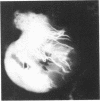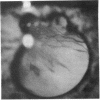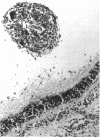Abstract
A case of intraocular toxocara larva migrans occurring in a 12-year-old boy is presented. Motility is inferred from the nature of multiple intraocular lesions observed. Possible mechanisms preventing a conclusive immunological response to the organism are discussed.
Full text
PDF





Images in this article
Selected References
These references are in PubMed. This may not be the complete list of references from this article.
- Dudgeon J. A. Virus infections of the upper respiratory tract (abridged). Proc R Soc Med. 1969 Jan;62(1):1–2. doi: 10.1177/003591576906200101. [DOI] [PMC free article] [PubMed] [Google Scholar]
- Duguid I. M. CHRONIC ENDOPHTHALMITIS DUE TO TOXOCARA. Br J Ophthalmol. 1961 Nov;45(11):705–717. doi: 10.1136/bjo.45.11.705. [DOI] [PMC free article] [PubMed] [Google Scholar]
- Ghafoor S. Y., Smith H. V., Lee W. R., Quinn R., Girdwood R. W. Experimental ocular toxocariasis: a mouse model. Br J Ophthalmol. 1984 Feb;68(2):89–96. doi: 10.1136/bjo.68.2.89. [DOI] [PMC free article] [PubMed] [Google Scholar]
- Kayes S. G., Oaks J. A. Development of the granulomatous response in murine toxocariasis. Initial events. Am J Pathol. 1978 Nov;93(2):277–294. [PMC free article] [PubMed] [Google Scholar]
- NICHOLS R. L. The etiology of visceral larva migrans. I. Diagnostic morphology of infective second-stage Toxocara larvae. J Parasitol. 1956 Aug;42(4 SECTION):349–362. [PubMed] [Google Scholar]
- O'Connor P. R. Visceral larva migrans of the eye. Subretinal tube formation. Arch Ophthalmol. 1972 Nov;88(5):526–529. doi: 10.1001/archopht.1972.01000030528011. [DOI] [PubMed] [Google Scholar]
- Olson L. J. Ocular toxocariasis in mice: distribution of larvae and lesions. Int J Parasitol. 1976 Jun;6(3):247–251. doi: 10.1016/0020-7519(76)90042-4. [DOI] [PubMed] [Google Scholar]
- Orfanakis N. G., Ostlund R. E., Bishop C. R., Athens J. W. Normal blood leukocyte concentration values. Am J Clin Pathol. 1970 May;53(5):647–651. doi: 10.1093/ajcp/53.5.647. [DOI] [PubMed] [Google Scholar]
- PARSONS H. E. Nematode chorioretinitis; report of a case, with photographs of a viable worm. AMA Arch Ophthalmol. 1952 Jun;47(6):799–800. [PubMed] [Google Scholar]
- Rockey J. H., Donnelly J. J., Stromberg B. E., Laties A. M., Soulsby E. J. Immunopathology of ascarid infection of the eye. Role of IgE antibodies and mast cells. Arch Ophthalmol. 1981 Oct;99(10):1831–1840. doi: 10.1001/archopht.1981.03930020705017. [DOI] [PubMed] [Google Scholar]
- Rubin M. L., Kaufman H. E., Tierney J. P., Lucas H. C. An intraretinal nematode (a case report). Trans Am Acad Ophthalmol Otolaryngol. 1968 Nov-Dec;72(6):855–866. [PubMed] [Google Scholar]
- Shields J. A. Ocular toxocariasis. A review. Surv Ophthalmol. 1984 Mar-Apr;28(5):361–381. doi: 10.1016/0039-6257(84)90242-x. [DOI] [PubMed] [Google Scholar]
- Smith H. V., Quinn R., Kusel J. R., Girdwood R. W. The effect of temperature and antimetabolites on antibody binding to the outer surface of second stage Toxocara canis larvae. Mol Biochem Parasitol. 1981 Dec;4(3-4):183–193. doi: 10.1016/0166-6851(81)90017-7. [DOI] [PubMed] [Google Scholar]
- Watzke R. C., Oaks J. A., Folk J. C. Toxocara canis infection of the eye. Correlation of clinical observations with developing pathology in the primate model. Arch Ophthalmol. 1984 Feb;102(2):282–291. doi: 10.1001/archopht.1984.01040030226032. [DOI] [PubMed] [Google Scholar]










